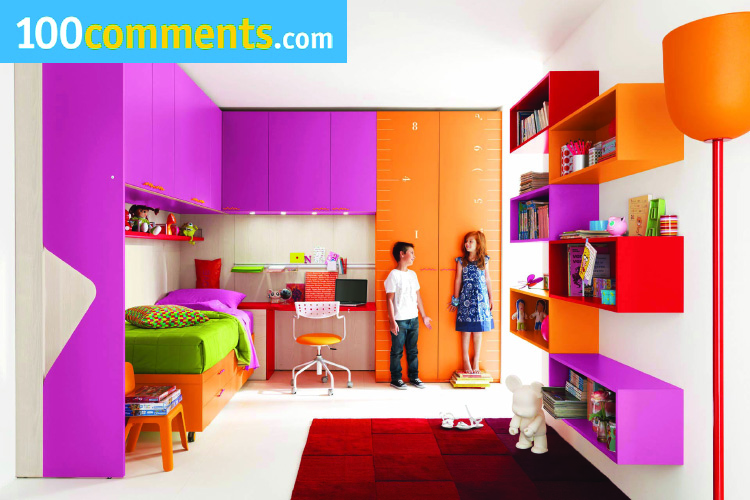Kids grow at a phenomenal rate, and sooner or later they’ll develop preferences, likes and dislikes. They’ll also want their bedrooms to be their own personal space which reflects on their own developing personalities. Decorating a room to suit these tastes is easier said than done but it can still be an enjoyable experience for kids and parents alike.
Table of Contents
Start with a room plan
You’ll need:
- A measuring tape
- Note book and pen
Measure and jot down the exact measurements of the entire room, from wall to wall. Note too, where the doors, windows and closets are. Discuss with your child to get ideas of how they would want their ‘dream room’ to look like. You can make a simple drawing of the room dimensions on plain paper. From there, you can plan the layout of the furniture and ‘rearrange’ them until your child decides on the ideal plan.
Know your budget (and stick within that limit)
Decide on a budget amount and vow to stick to it. Discuss the budget with your child; this is a good opportunity to teach them about money management and appreciation. Include your child’s opinion to help in the decision making process when it comes to prioritizing purchases for the room.
Versatility
Choosing the right furniture for instance, can be a challenge, especially if you are dealing with a child’s whims and fancies. Some children also have a tendency to change their preferences regularly, especially to match up with current trends. In this situation, finding a lasting set of ideas when decorating the kid’s room would be the smartest step to take.
Unless you don’t mind a total makeover in a few years (or perhaps less!), entertain your child’s fancies for a certain trend with bed-sheets, comforters, rugs, curtain and posters of his fancied movie/sports/cartoon character instead of purchasing a whole bedroom set with that one theme. Using your creativity, there are many ways you can accommodate a child’s fancy or obsession for a trend realistically and wisely.
Theming and scheming
Select a theme and choose a color scheme. It would be so much more easier if you need only pick and choose from bedroom items which fall in a certain theme or color scheme. Your child’s preferences are paramount here because they will be spending the most time in the room. On the upside, you’ll need only purchase things that fit the category for your child’s room, hence avoiding unnecessary purchases.
Storage a-plenty
Choose plenty of colorful storage options. Kids tend to have a lot of toys, clothes and shoes and these need to be stored away neatly. Well-selected storage containers, baskets and boxes can turn out to be attractive and decorative as well.
Clever spacing
Consider the many uses for a child’s bedroom and be sure to incorporate areas for each of these important elements of proper child growth:
- Sleep
- Study
- Play
If the room is small, consider ways to make some of the space do double-duty. One simple way to accomplish this is to buy or build a loft bed — similar to a bunk bed, but with only a top bunk.
The space under the sleeping area can be used to house either a study area with a desk and bookshelf, a TV area, a dressing area or a small play area. When you keep in mind the different uses for your child’s room, such as studying, sleeping and playing, it would be so much more easier to decorate accordingly.
Tip: Try to choose items that will “grow” with your child. Just as they quickly outgrew their need for a crib and changing table, they will continue to grow and develop, both physically and intellectually.
Consider full sized dressers and bed options and look for a desk that will still accommodate your child for a few years.
Space saving options
Unless space is not an issue, picking out furniture that can serve more than one purpose makes the most sense. For example, a headboard that can double as a bookcase, or storage chests that double as step-stools.
Toy chests can make great seats too. Bunk beds are a fantastic option if two children are sharing a room or for sleepovers. Trundle beds are great too because the second bed can slide underneath the main bed to give more room for your child to play when it’s not in use.
Safety concerns
You should always look for sturdy furniture that is made well. Children tend to be rough on their furniture so it should be able to withstand a lot of wear and tear.
Watch out for obvious safety hazards, such as loose safety rails on bunk beds or ladders that are flimsy or not secured properly.
On the wall
- Your child’s drawings and artworks can be transformed into stylish and unique wall deco.
- Removable wall stickers can be changed easily and they give the room a fresh new look.
- Paint your child’s room in a bright color and then purchase an additional paint color that is complementary to the first color and use stencils to draw designs on your kid’s walls. Stencils are inexpensive and can easily be found at craft stores. You can even find stencil patterns online.
- Enlarge their favourite photos, frame them and hang these on the wall for a personalised touch that is unique to their tastes only.
- If your child is into posters, set up an attractive poster wall. The trick for visual appeal is to keep one common and consistent element on the posters — either the size, color, frame, etc.
















